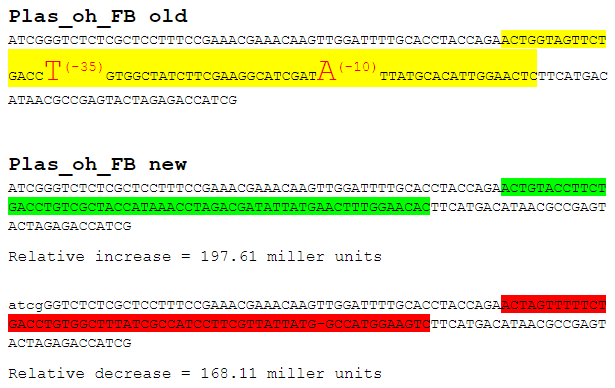| Line 17: | Line 17: | ||
<p> To read more about our promoter optimisation tool, please click <a href="https://2018.igem.org/Team:Manchester/PromoterModel">here</a>. | <p> To read more about our promoter optimisation tool, please click <a href="https://2018.igem.org/Team:Manchester/PromoterModel">here</a>. | ||
<p> | <p> | ||
| − | We received three inducible promoter sequences from the <a href="https://2018.igem.org/Team:Duesseldorf">University of <b>Duesseldorf</b> iGEM team.</a> We ran each sequence through an online algorithm (<a target="_blank" href="http://www.fruitfly.org/seq_tools/promoter.html"/>see here</a>) to determine the likely -10 and -35 sites in each promoter. This was done in order to accurately compare the Dusseldorf sequences to the promoters in our database. Our tool works by assigning activities to each individual nucleotide at a particular position, so aligning the sequences this way was important). As the sequences we used for our project (obtained from <a href="https://www.ncbi.nlm.nih.gov/pmc/articles/PMC124675/figure/F4/">Jensen and Hammer, 1998</a> | + | We received three inducible promoter sequences from the <a href="https://2018.igem.org/Team:Duesseldorf">University of <b>Duesseldorf</b> iGEM team.</a> We ran each sequence through an online algorithm (<a target="_blank" href="http://www.fruitfly.org/seq_tools/promoter.html"/>see here</a>) to determine the likely -10 and -35 sites in each promoter. This was done in order to accurately compare the Dusseldorf sequences to the promoters in our database. Our tool works by assigning activities to each individual nucleotide at a particular position, so aligning the sequences this way was important). As the sequences we used for our project (obtained from <a href="https://www.ncbi.nlm.nih.gov/pmc/articles/PMC124675/figure/F4/">Jensen and Hammer, 1998)</a> were each only 60 nucleotides long, and Dusseldorf’s promoters were longer, we, unfortunately, could only optimize a small section of each promoter that contained the -35 and -10 sites. We have highlighted the parts of the promoters we were able to optimize in yellow. <br> |
We began designing the promoters to increase their relative activity. However, we realised that as Dusseldorf were using inducible promoters, they likely wanted to keep readthrough expression levels low. Therefore, we also determined the most optimal sequences for keeping readthrough expression levels low, with the results shown below. <br> | We began designing the promoters to increase their relative activity. However, we realised that as Dusseldorf were using inducible promoters, they likely wanted to keep readthrough expression levels low. Therefore, we also determined the most optimal sequences for keeping readthrough expression levels low, with the results shown below. <br> | ||
Revision as of 16:55, 17 October 2018
COLLABORATIONS

How did we collaborate?
iGEM Duesseldorf - Promoter Optimisation Tool
To read more about our promoter optimisation tool, please click here.
We received three inducible promoter sequences from the University of Duesseldorf iGEM team. We ran each sequence through an online algorithm (see here) to determine the likely -10 and -35 sites in each promoter. This was done in order to accurately compare the Dusseldorf sequences to the promoters in our database. Our tool works by assigning activities to each individual nucleotide at a particular position, so aligning the sequences this way was important). As the sequences we used for our project (obtained from Jensen and Hammer, 1998) were each only 60 nucleotides long, and Dusseldorf’s promoters were longer, we, unfortunately, could only optimize a small section of each promoter that contained the -35 and -10 sites. We have highlighted the parts of the promoters we were able to optimize in yellow.
We began designing the promoters to increase their relative activity. However, we realised that as Dusseldorf were using inducible promoters, they likely wanted to keep readthrough expression levels low. Therefore, we also determined the most optimal sequences for keeping readthrough expression levels low, with the results shown below.
The sequences that have been optimized for increased activity are highlighted in green and the ones that have been optimized for decreased activity are highlighted in red.
The estimated activity change for each new sequence can be found just below the sequence itself, labelled as either "relative increase" or "relative decrease".



UK iGEM Meetup 12th - 13th July

We (Tom, Ed, Ryan and Nam) attended the UK iGEM meetup in July in Oxford and presented a poster about our project plans.
Thank you to SynBio.UK and SynBio.Oxford for hosting all the UK teams and giving us the opportunity to discuss projects with the other UK teams!
Surveys
We also helped some teams fill out some surveys for their human practices, linked below:

